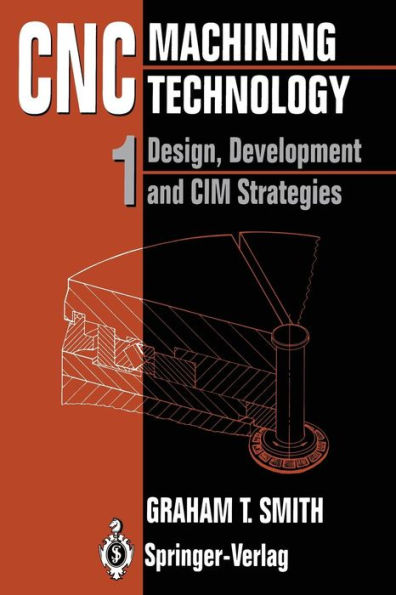CNC Machining Technology: Volume I: Design, Development and CIM Strategies
The first part of Volume I outlines the origins and development of CNC machine tools. It explains the construction of the equipment and also discusses the various elements necessary to ensure high quality of production. The second part considers how a company justifies the purchase of either cells or systems and illustrates why simulation exercises are essential prior to a full implementation. Communication prools as well as networking topologies are examined. Finally, the important high-speed machining developments and the drive towards ultra-high precision are mentioned. Following a brief historical introduction to cutting tool development, chapters 1 and 2 of Volume II explain why CNC requires a change in cutting tool technology from conventional methods. A presentation is given of the working knowledge of cutting tools and cutting fluids which is needed to make optimal use of the productive capacity of CNC machines. Since an important consideration for any machine tool is how one can locate and restrain the workpiece in the correct orientation and with the minimum of set-up time, chapter 3 is concerned with workholding technology. Volume III deals with CNC programming. It has been written in conjunction with a major European supplier of controllers in order to give the reader a more consistent and in-depth understanding of the logic used to program such machines. It explains how why and where to program specific features of a part and how to build them up into complete programs. Thus, the reader will learn about the main aspects of the logical structure and compilation of a program. Finally, there is a brief review of so me of the typical controllers currently available from both universal and proprietary builders.
1114812498
CNC Machining Technology: Volume I: Design, Development and CIM Strategies
The first part of Volume I outlines the origins and development of CNC machine tools. It explains the construction of the equipment and also discusses the various elements necessary to ensure high quality of production. The second part considers how a company justifies the purchase of either cells or systems and illustrates why simulation exercises are essential prior to a full implementation. Communication prools as well as networking topologies are examined. Finally, the important high-speed machining developments and the drive towards ultra-high precision are mentioned. Following a brief historical introduction to cutting tool development, chapters 1 and 2 of Volume II explain why CNC requires a change in cutting tool technology from conventional methods. A presentation is given of the working knowledge of cutting tools and cutting fluids which is needed to make optimal use of the productive capacity of CNC machines. Since an important consideration for any machine tool is how one can locate and restrain the workpiece in the correct orientation and with the minimum of set-up time, chapter 3 is concerned with workholding technology. Volume III deals with CNC programming. It has been written in conjunction with a major European supplier of controllers in order to give the reader a more consistent and in-depth understanding of the logic used to program such machines. It explains how why and where to program specific features of a part and how to build them up into complete programs. Thus, the reader will learn about the main aspects of the logical structure and compilation of a program. Finally, there is a brief review of so me of the typical controllers currently available from both universal and proprietary builders.
109.99
In Stock
5
1

CNC Machining Technology: Volume I: Design, Development and CIM Strategies
178
CNC Machining Technology: Volume I: Design, Development and CIM Strategies
178Paperback(1993)
$109.99
109.99
In Stock

Product Details
| ISBN-13: | 9783540198284 |
|---|---|
| Publisher: | Springer London |
| Publication date: | 05/07/1993 |
| Edition description: | 1993 |
| Pages: | 178 |
| Product dimensions: | 6.10(w) x 9.25(h) x 0.02(d) |
From the B&N Reads Blog
